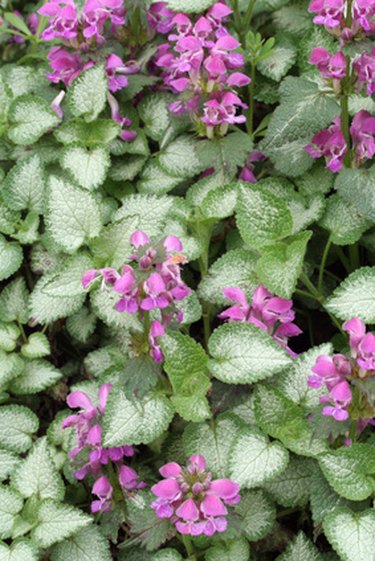
Ground covers are low-growing plants that form dense mats as they quickly spread over the soil. These plants are often used to control erosion and manage weeds in rocky landscapes and shady areas. Grass is a suitable ground cover for many areas, but other options are available where grass is hard to grow or maintain. Because of the high initial cost of installing ground covers, using plants native to your area can be a cost-effective option. There are many ground covers native to South Carolina. A quick check with your local cooperative extension service will yield a selection of suitable ground covers for your property.
Carolina Jessamine
Video of the Day
This tough perennial, twining vine adapts well to many settings, spreading over fields and climbing high into tall trees. The oblong, glossy, dark-green leaves are evergreen and turn yellowish or purple shades in winter. Yellow, funnel-shaped flowers form on the end of stems blooming briefly in early spring. Though a vigorous climber, the vines will also trail along the ground to form a thick, carpet-like cover, making it useful in preventing soil erosion on steep banks. Carolina jessamine vines grow best in well-drained, moist soil in full sun or partial shade.
Video of the Day
Mountain Spurge
This perennial ground cover thrives in full to partial shade and spreads by underground runners. The evergreen stems and leaves form upright clumps. The marbled, gray-to-dark green leaves are heavily toothed and clusters of fragrant white flowers form at the ends of spikes blooming in spring or early summer. Mountain spurge is useful in shrub borders and woodland gardens growing in all soil types (except very dry soil), according to the American Horticultural Society.
Shrubby St. John's Wort
This small, deciduous spreading shrub has upright branching of red to purple bark with blue-green leaves. The dense, round-shaped mounds grow from 1 to 4 feet tall. Large, yellow flowers bloom in early summer to midsummer, singly or in small clusters. This perennial grows in dry to moist soil under full sun to light shade. Cone-shaped seed pods form in fall and split open to drop black seeds. The older, gray bark peels back to reveal a pale orange interior. You can grow in mass as ground cover to stabilize slopes. You can rejuvenate the St. John's Wort shrubs by cutting them back to ground level every spring.